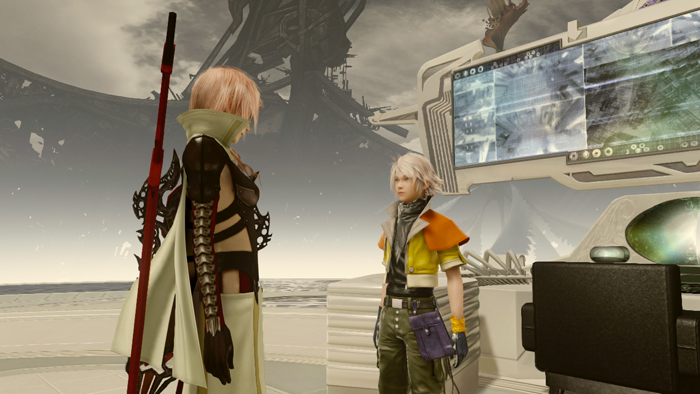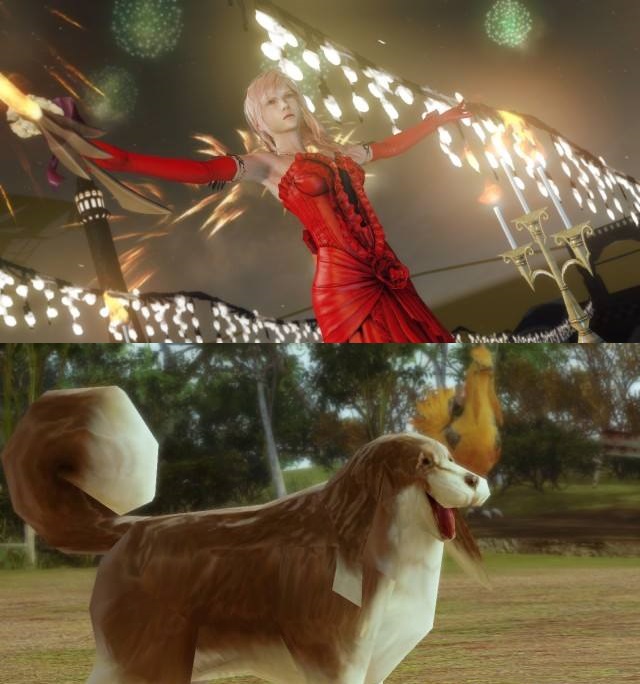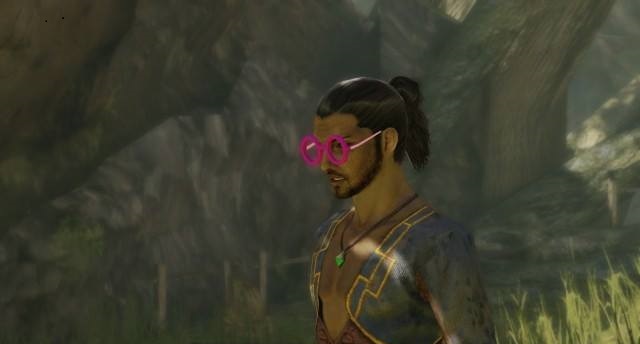Final Fantasy has been around for a long time, and was once arguably the best of a genre that displayed a lot of quality. An observant person might even say that there are parallels in how Final Fantasy has evolved and how JRPG’s have fared in the last and current consoles generations. The original outing of the 13 series is one of the most reviled games of the generation, and is considered by many to be the worst Final Fantasy ever. Final Fantasy 13-2 seemed to go under the radar among scoffs at the mere thought of 13 getting a sequel. It is clear that Square-Enix understands that the name Final Fantasy no longer carries the cache it once had: Bravely Default is not a Final Fantasy title despite being closer to what most fans think of the series than the 13 series ever was. Despite all this, Square-Enix developed a third game in the Final Fantasy 13 story, the strangely titled ‘Lightning Returns: Final Fantasy 13.’ Released at the waning days of the the 7th generation for Xbox 360 and PS3, Lightning Returns is easily the best game of the 13 series, though it is far from a perfect game. Like JRPG’s as a whole, Square-Enix seems to have finally found a working formula for a genre that struggled to adapt and remain relevant in the new gaming landscape. Lightning Returns itself is a mixed bag, but one that can be a lot of fun for those able to overlook its flaws.
In the last episode of Dragon Bal- the Final Fantasy 13 series, Etro, the goddess of death, was killed by the machinations of Caius, the villian of the game. Serah, Lightning’s sister, died in the process and Lightning herself was sealed in crystal for 500 years. As a result people have stopped aging, and therefore reproducing. Children are stuck as children, old folks as old folks, etc… The death of Etro also caused a force known as Chaos to slowly consume the world, and by the time the game begins, all but the four areas where the game takes place have been consumed. Bhunivelze, who most of the times is just referred to as ‘God’ in the game, decides he won’t even try saving the world. Instead in thirteen days he will destroy the world and make a new one somewhere else. He brings Lightning back and tasks her to save as many souls as possible to take to the new world as possible before the end. In return, God promises to bring back Serah. The setting in itself has potential, but as it is often the case with the Final Fantasy 13 series it is wasted by the execution. God comes back in thirteen days but the world is actually ending in seven because of Chaos. Lightning then has to use the godly energy she receives from saving souls to rejuvenate Yggdrasil, the world tree, therefore extending the life of the world long enough for Bhunivelze to come and destroy it.
The plot is simultaneously convoluted and painfully predictable. The legacy of the first two games clearly weighs it down because while Lightning Returns tries to make it accessible to those who did not play those titles, there are a lot of plot points, locations, and details that do require knowledge of the events of the previous entries in order to make sense. This also means we are stuck with the same cast from the 13 series, as Hope takes the role of support. The plot still involves the quest for Serah and Lightning to be reunited, and the same vague themes of freedom and slavery that are ultimately lost underneath a non-sensical plot and ramblings of family and friendship. The dialogue does not help, not only is it boring and uninspired, but it has an annoying tendency of repeating things several times during the course of the conversation, even if they are things that the player should have figured out already or that they have explained before. Lightning herself is well acted which is somewhat ironic, since the game claims Bhunivelze took away all of her emotions to make her more efficient. Interestingly enough, I’ve seen her emote more in this game than any other in the series. She shows anger, compassion, she can be snarky, or kind though a lot of times she sounds just bored. In general the voice acting of the main characters is good, but a lot of the voice acting for NPCs and minor characters just falls flat.
This seems to be a trend in Lightning Returns, some things are done very well, while others are done very badly, and in a lot of cases they are the same things. The most evident example is the disparity in the graphics. Lightning and her many outfits are rendered in high quality and loving detail. Some of the cut-scenes are beautifully rendered and animated. The rest of the game? Not so much. A lot of the textures are so low quality they look like they belong in different games entirely. It is particularly jarring on the NPC’s as there are a handful of character models, and as you travel the world, you will meet them several times. Often the only difference between them is a small detail, like a hat, or a pair of glasses, but the models and the items themselves are so badly done, it looks like the same person wearing a really bad disguise.
Side quests have the same issue. Some of them make great use of the setting to provide some great narrative experiences. People have been alive for 500 years after all, and most of them seem to have fallen in a rut, losing sight of passions or things that were important to them and sometimes forgetting entire sections of their life as they just kind of sit there waiting for the world to end. Some quests make great use of this, such as one in which Lightning has to find the journal of the very early life of a man. Other quests ranged from involved to humorous. However, much like everything else in Lightning returns the quality of the quests is not even. There are a lot of quests that are just simple fetch quests, or even worse, quests that require the player to speak to the same character at the same time a few days in a row.
The in-game clock in general is under-utilized. Initially it seems that the clock will force the player to hurry along and hamper exploration, and for the first few days that’s a fair assessment. There is an ability called Chronostasis that will stop the clock using EP, a special type of point that’s tied to several abilities, including teleporting, healing Lightning, reviving her during battle, and a special ability for battles called overclock. EP can be restored fighting monsters, but in the first few days it takes a while to earn one point. However as the game continues and tougher enemies become more common, and the player increases Lightning’s EP capacity it is very easy to keep the EP meter full and not feel pressured by time at all, and it only becomes a manner of restricting access to certain events or places. The game also makes a huge point of the need to complete quests in order to extend the world’s life-span, but it is possible to easily finish the game within 5 days if you know what you are doing. I personally ran out of story in the 7th day, then had to wait for the clock to run out.
Fortunately, the combat and equipment systems are the best part of Lightning Returns. Players assign commands to each of the face buttons, ranging from things like attack, guard, and magic spells, to more specific ones such as blitz or different magical combinations. Each of these abilities decrease the ATB gauge, which determines the number of certain actions Lightning can perform. During battle, she can change between three Schemata, three different set ups that represent different roles in a party. While a Schemata is active , the other two refresh their ATB gauge. Schemata are incredibly customizable, with about 75 outfits included in the game, and a host of weapons, game changing accessories, and shields, it is a marvel that the set ups feel as balanced as they are. Planning and Schemata set up can drastically affect the course of a battle. Lighting Returns is quite unforgiving, punishing rushing into battle, and rewarding careful thought and planning, especially when fighting bosses. To add another layer of complexity the number of recovery items Lighting carries is limited. The game starts with six, though this number expands as the game goes on. Early in the game, the player must choose whether to use precious EP, or money to buy more recovery items. While this disappears as bigger enemies drop more money and more EP, it does mean that early in the game the player must choose their moves carefully.
It is hard to make a recommendation for or against Lightning Returns. Fans of the Final Fantasy 13 series, I imagine, will be thrilled by the send off for the series. This is by far the best entry of the three. However for other players it will be a harder call. There is definitely a good game in there, the combat is great, and destroying bosses was fun once I figured out the Schemata system. But the game is also inconsistent. More importantly, I don’t think I could fault any player who dislikes the two other games in the 13 series if they dropped it after five minutes of listening to the same characters talk. It feels like Lightning Returns may have been a much better game if it had the chance to stand on its own rather than having all the baggage that the Final Fantasy name now has coming with it. If you can see past its inconsistency, and past the terrible story and awful characters, then it is worth looking into. If you are looking for a more traditional return to Final Fantasy, a coherent story or you did not like the first two games of the 13 series, then you should pass. Now, if you’ll excuse me, I will enjoy a delicious Toblerone.










